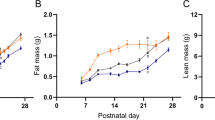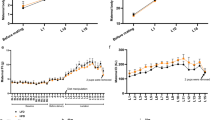Abstract
Objective:
Key appetite regulators and their receptors are already present in the fetal hypothalamus, and may respond to hormones such as leptin. Intrauterine food restriction or hyperglycemia can reprogram these circuits, possibly predisposing individuals to adverse health outcomes in adulthood. Given the global obesity epidemic, maternal overweight and obesity is becoming more prevalent. Earlier, we observed rapid growth of pups from obese dams during the suckling period. However, it is unclear whether this is because of alterations in leptin and hypothalamic appetite regulators at birth.
Design:
Female Sprague–Dawley rats were fed palatable high-fat diet (HFD) or chow for 5 weeks to induce obesity before mating. The same diet continued during gestation. At day 1, after birth, plasma and hypothalamus were collected from male and female pups.
Measurements:
Body weight and organ mass were recorded. Leptin and insulin levels were measured in the plasma by radioimmunoassay. Hypothalamic mRNA expression of neuropeptide-Y (NPY), pro-opiomelanocortin, leptin receptor and its downstream signal, STAT3 (signal transducer and activator of transcription 3), were measured using real-time PCR.
Results:
Body and organ weights of pups from obese dams were similar to those from lean dams, across both genders. However, plasma leptin levels were significantly lower in offspring from obese dams (male: 0.53±0.13 vs 1.05±0.21 ng ml−1; female: 0.33±0.09 vs 2.12±0.57 ng ml−1, respectively; both P<0.05). Hypothalamic mRNA expression of NPY, pro-opiomelanocortin, leptin receptor and STAT3 were also significantly lower in pups from obese dams.
Conclusion:
Long-term maternal obesity, together with lower leptin levels in pups from obese dams may contribute to the lower expression of key appetite regulators on day 1 of life, suggesting altered intrauterine neuron development in response to intrauterine overnutrition, which may contribute to eating disorders later in life.
This is a preview of subscription content, access via your institution
Access options
Subscribe to this journal
Receive 12 print issues and online access
$259.00 per year
only $21.58 per issue
Buy this article
- Purchase on Springer Link
- Instant access to full article PDF
Prices may be subject to local taxes which are calculated during checkout




Similar content being viewed by others
References
Grove KL, Grayson BE, Glavas MM, Xiao XQ, Smith MS . Development of metabolic systems. Physiol Behav 2005; 86: 646–660.
Ahima RS, Prabakaran D, Flier JS . Postnatal leptin surge and regulation of circadian rhythm of leptin by feeding. Implications for energy homeostasis and neuroendocrine function. J Clin Invest 1998; 101: 1020–1027.
Wynne K, Stanley S, McGowan B, Bloom S . Appetite control. J Endocrinol 2005; 184: 291–318.
Friedman JM, Halaas JL . Leptin and the regulation of body weight in mammals. Nature 1998; 395: 763–770.
Schwartz MW, Woods SC, Porte DJ, Seeley RJ, Baskin DG . Central nervous system control of food intake. Nature 2000; 404: 661–671.
Pinto S, Roseberry AG, Liu H, Diano S, Shanabrough M, Cai X et al. Rapid rewiring of arcuate nucleus feeding circuits by leptin. Science 2004; 304: 110–115.
Mistry AM, Swick A, Romsos DR . Leptin alters metabolic rates before acquisition of its anorectic effect in developing neonatal mice. Am J Physiol Regul Integr Comp Physiol 1999; 277: R742–R747.
Roberts TJ, Nijland MJ, Caston-Balderrama A, Ross MG . Central leptin stimulates ingestive behavior and urine flow in the near term ovine fetus. Horm Metab Res 2001; 33: 144–150.
Bouret SG, Simerly RB . Developmental programming of hypothalamic feeding circuits. Clin Genet 2006; 70: 295–301.
Yura S, Itoh H, Sagawa N, Yamamoto H, Masuzaki H, Nakao K et al. Role of premature leptin surge in obesity resulting from intrauterine undernutrition. Cell Metab 2005; 1: 371–378.
Iliadou A, Cnattingius S, Lichtenstein P . Low birthweight and Type 2 diabetes: A study on 11 162 Swedish twins. Int J Epidemiol 2004; 33: 948–953.
Yeh J, Shelton JA . Increasing prepregnancy body mass index: analysis of trends and contributing variables. Am J Obest Gynecol 2005; 193: 1994–1998.
Chen H, Simar D, Lambert K, Mercier J, Morris MJ . Intrauterine and postnatal overnutrition differentially impact appetite regulators and fuel metabolism. Endocrinology 2008; 149: 5348–5356.
Samuelsson A-M, Matthews PA, Argenton M, Christie MR, McConnell JM, Jansen EHJM et al. Diet-induced obesity in female mice leads to offspring hyperphagia, adiposity, hypertension, and insulin resistance. A novel murine model of developmental programming. Hypertension 2007; 51: 383–392.
Zhang Y, Proenca R, Maffei M, Barone M, Leopold L, Friedman JM . Positional cloning of the mouse obese gene and its human homologue. Nature 1994; 372: 425–432.
Bi S, Gavrilova O, Gong DW, Mason MM, Reitman M . Identification of a placental enhancer for the human leptin gene. J Biol Chem 1997; 272: 30583–30588.
Bado A, Levasseur S, Attoub S, Kermorgant S, Laigneau JP, Bortoluzzi MN et al. The stomach is a source of leptin. Nature 1998; 394: 790–793.
Hoggard N, Hunter L, Duncan JS, Williams LM, Trayhurn P, Mercer JG . Leptin and leptin receptor mRNA and protein expression in the murine fetus and placenta. Proc Natl Acad Sci USA 1997; 94: 11073–11078.
Stocker CJ, Wargent E, O’Dowd J, Cornick C, Speakman JR, Arch JRS et al. Prevention of diet-induced obesity and impaired glucose tolerance in rats following administration of leptin to their mothers. Am J Physiol Regul Integr Comp Physiol 2007; 292: R1810–R1818.
Miralles O, Sanchez J, Palou A, Pico C . A physiological role of breast milk leptin in body weight control in developing infants. Obesity 2006; 14: 1371–1377.
Persson B, Westgren M, Celsi G, Nord E, Ortqvist E . Leptin concentrations in cord blood in normal newborn infants and offspring of diabetic mothers. Horm Metab Res 1999; 31: 467–471.
Gross GA, Solenberger T, Philpott T, Holcomb WL, Landt M . Plasma leptin concentrations in newborns of diabetic and nondiabetic mothers. Am J Perinatol 1998; 15: 243–247.
Bajoria R, Sooranna SR, Ward BS, Chatterjee R . Prospective function of placental leptin at maternal-fetal interface. Placenta 2002; 23: 103–115.
Desoye G, Hauguel-de Mouzon S . The human placenta in gestational diabetes mellitus. The insulin and cytokine network. Diabetes Care 2007; 30 (Suppl 2): S120–S126.
Smith JT, Waddell BJ . Leptin distribution and metabolism in the pregnant rat: transplacental leptin passage increases in late gestation but is reduced by excess glucocorticoids. Endocrinology 2003; 144: 3024–3030.
Banks WA, Coon AB, Robinson SM, Moinuddin A, Shultz JM, Nakaoke R et al. Triglycerides induce leptin resistance at the blood-brain barrier. Diabetes 2004; 53: 1253–1260.
Bayol SA, Farrington SJ, Stickland NC . A maternal ‘junk food’ diet in pregnancy and lactation promotes an exacerbated taste for ‘junk food’ and a greater propensity for obesity in rat offspring. Br J Nutr 2007; 98: 843–851.
Gorski JN, Dunn-Meynell AA, Hartman TG, Levin BE . Postnatal environment overrides genetic and prenatal factors influencing offspring obesity and insulin resistance. Am J Physiol Regul Integr Comp Physiol 2006; 291: R768–R778.
Caluwaerts S, Lambin S, van Bree R, Peeters H, Vergote I, Verhaeghe J . Diet-induced obesity in gravid rats engenders early hyperadiposity in the offspring. Metabolism 2007; 56: 1431–1438.
Ben X, Qin Y, Wu S, Zhang W, Cai W . Placental leptin correlates with intrauterine fetal growth and development. Chin Med J 2001; 114: 636–639.
Christou H, Serdy S, Mantzoros CS . Leptin in relation to growth and developmental processes in the fetus. Semin Reprod Med 2002; 20: 123–130.
Wilkin TJ, Murphy MJ . The gender insulin hypothesis: why girls are born lighter than boys, and the implications for insulin resistance. Int J Obes 2006; 30: 1056–1061.
Bouret SG, Draper SJ, Simerly RB . Formation of projection pathways from the arcuate nucleus of the hypothalamus to hypothalamic regions implicated in the neural control of feeding behavior in mice. J Neurosci 2004; 24: 2797–2805.
Pan W, Hsuchou H, Tu H, Kastin AJ . Developmental changes of leptin receptors in cerebral microvessels: unexpected relation to leptin transport. Endocrinology 2008; 149: 877–885.
Faouzi M, Leshan R, Bjornholm M, Hennessey T, Jones J, Munzberg H . Differential accessibility of circulating leptin to individual hypothalamic sites. Endocrinology 2007; 148: 5414–5423.
Benomar Y, Roy AF, Aubourg A, Djiane J, Taouis M . Cross down-regulation of leptin and insulin receptor expression and signalling in a human neuronal cell line. Biochem J 2005; 388: 929–939.
Carvalheira JB, Siloto RM, Ignacchitti I, Brenelli SL, Carvalho CR, Leite A et al. Insulin modulates leptin-induced STAT3 activation in rat hypothalamus. FEBS Lett 2001; 500: 119–124.
Beloosesky R, Gayle DA, Amidi F, Ahanya SN, Desai M, Ross MG . Ontogenic expression of putative feeding peptides in the rat fetal brain and placenta. Nutr Neurosci 2006; 9: 33–40.
Hansen MJ, Jovanovska V, Morris MJ . Adaptive responses in hypothalamic neuropeptide Y in the face of prolonged high-fat feeding in the rat. J Neurochem 2004; 88: 909–916.
Morris MJ, Chen H, Watts R, Shulkes A, Cameron-Smith D . Brain neuropeptide Y and CCK and peripheral adipokine receptors: temporal response in obesity induced by palatable diet. Int J Obes 2008; 32: 249–258.
Huang XF, Han M, South T, Storlien L . Altered levels of POMC, AgRP and MC4-R mRNA expression in the hypothalamus and other parts of the limbic system of mice prone or resistant to chronic high-energy diet-induced obesity. Brain Res 2003; 992: 9–19.
Balthasar N, Dalgaard LT, Lee CE, Yu J, Funahashi H, Williams T et al. Divergence of melanocortin pathways in the control of food intake and energy expenditure (comment in: Cell 2004 29: 313–314). Cell 2005; 123: 493–505.
Benoit SC, Schwartz MW, Lachey JL, Hagan MM, Rushing PA, Blake KA et al. A novel selective melanocortin-4 receptor agonist reduces food intake in rats and mice without producing aversive consequences. J Neurosci 2000; 20: 3442–3448.
Hansen MJ, Schioth HB, Morris MJ . Feeding responses to a melanocortin agonist and antagonist in obesity induced by a palatable high-fat diet. Brain Res 2005; 1039: 137–145.
Cota D, Proulx K, Smith KA, Kozma SC, Thomas G, Woods SC et al. Hypothalamic mTOR signaling regulates food intake. Science 2006; 312: 927–930.
Bouret SG, Draper SJ, Simerly RB . Trophic action of leptin on hypothalamic neurons that regulate feeding. Science 2004; 304: 108–110.
Delahaye F, Breton C, Risold PY, Enache M, Dutriez-Casteloot I, Laborie C et al. Maternal perinatal undernutrition drastically reduces postnatal leptin surge and affects the development of arcuate nucleus proopiomelanocortin neurons in neonatal male rat pups. Endocrinology 2008; 149: 470–475.
Vickers MH, Gluckman PD, Coveny AH, Hofman PL, Cutfield WS, Gertler A et al. Neonatal leptin treatment reverses developmental programming. Endocrinology 2005; 146: 4211–4216.
Acknowledgements
This work was supported by project grant funding from the National Health and Medical Research Council of Australia to Margaret Morris.
Author information
Authors and Affiliations
Corresponding author
Rights and permissions
About this article
Cite this article
Morris, M., Chen, H. Established maternal obesity in the rat reprograms hypothalamic appetite regulators and leptin signaling at birth. Int J Obes 33, 115–122 (2009). https://doi.org/10.1038/ijo.2008.213
Received:
Revised:
Accepted:
Published:
Issue Date:
DOI: https://doi.org/10.1038/ijo.2008.213
Keywords
This article is cited by
-
Programming of metabolism by adipokines during development
Nature Reviews Endocrinology (2023)
-
The influence of maternal diet on offspring’s gut microbiota in early life
Archives of Gynecology and Obstetrics (2023)
-
Early life overnutrition impairs plasticity of non-neuronal brainstem cells and drives obesity in offspring across development in rats
International Journal of Obesity (2020)
-
Associations of prenatal exposure to impaired glucose tolerance with eating in the absence of hunger in early adolescence
International Journal of Obesity (2019)
-
Gold nanoparticles improve metabolic profile of mice fed a high-fat diet
Journal of Nanobiotechnology (2018)



